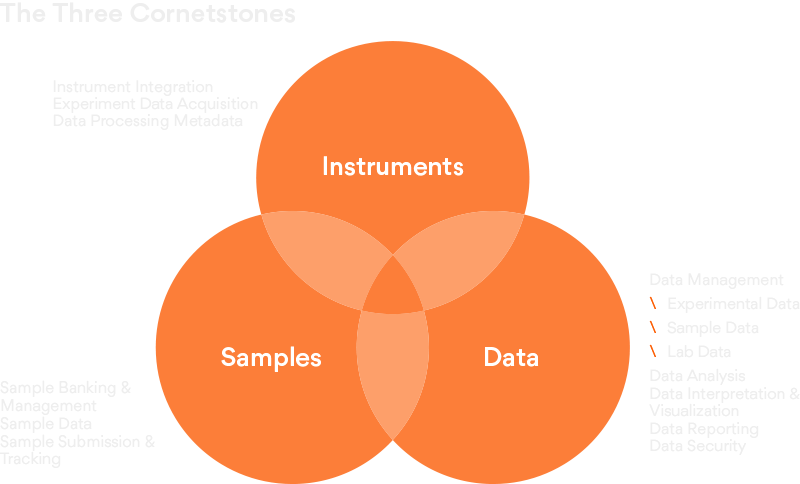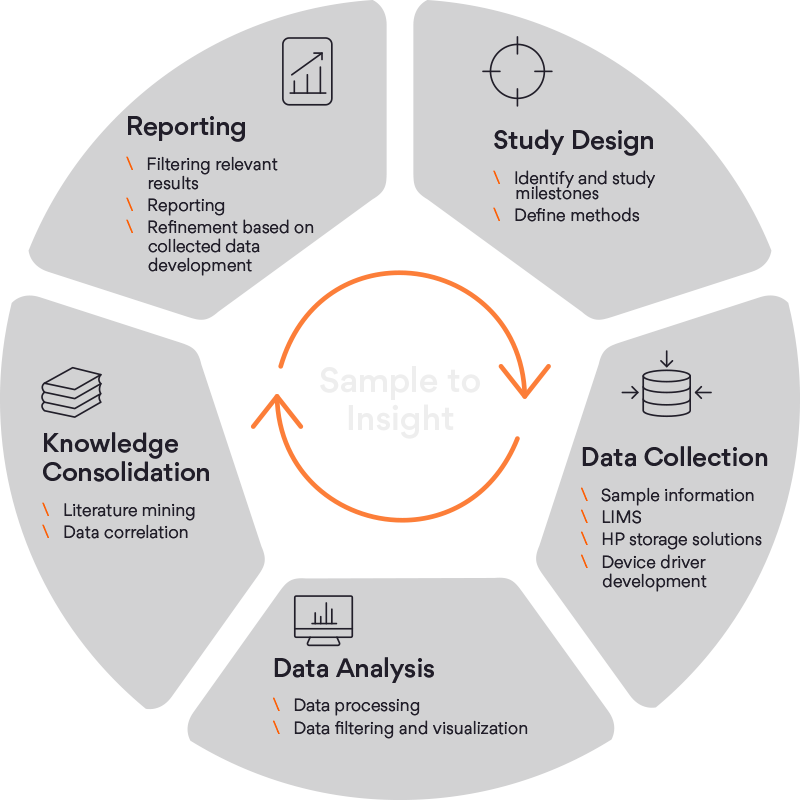Advanced scientific breakthroughs are resulting in innovative therapies that can improve the quality of life of patients suffering from chronic diseases. These scientific advances coupled with “technological disruptions” are not only changing the way how the research has been conducted but are also playing a critical role in devising evidence-based treatments. However, out of all the contributions, arguably the most significant contribution of technology to scientific research is in the field of clinical diagnostics where data generated from a sample is assessed, visualized, and interpreted.
New insights from the vast amounts of laboratory data are generated through an organized path that we call “Sample-to-Insights”, a multi-step process that requires innovative technological intervention.
Instruments, Samples, and Data form the three cornerstones of this process.
Sample Management includes the storage, processing, submission, and tracking.
Instrument Management includes integration, experimental setup, metadata set up, and processing.
Data Management includes the management of all data that needs to be integrated, stored, managed, and analyzed, including the necessary data security, visualization, and regulatory compliance
Sample-to-Insights Workflow
The key components of Sample-to-Insight workflow include experiment planning, sample preparation, sample submission, instrument control & data acquisition, data processing, data analysis, data visualization, data reporting, and finally data access, data sharing, and data security.
It is prudent to consider that in order to get useful insights from a sample, all the above stages of the workflow need to be integrated and brought onto a single platform.
The 4 Lab Data Challenges
Currently, many laboratories lack a robust mechanism to manage and analyze data.
- Disparate Data Sources
Multiple disparate data sources that are part of a laboratory environment include sample data, experimental data, pre-clinical data, clinical data, submission data, FDA correspondence, and operational data. The number of disparate sources poses significant challenges in lab data management. Moreover, standards around data access & availability, data ownership, and siloed analysis mechanisms are some of the problems that laboratories face today.
- Both Structured & Unstructured Data Sources
Another challenge that the labs face is that the data can exist in both a structured (e-Lab notebooks and other software) or an unstructured form (handwritten notes and lab notebooks). Hence, it is extremely difficult to decipher information from such diverse and critical sources of data, integrate it with other information systems and enable a seamless flow of information from one system to the other.
- Multiple Applications for Data Storage
Multiple smaller software applications, which pose significant challenges in providing a unified picture of the sample data which is a prerequisite for drawing effective insights. Disparate data storage systems, file formats, and standards, legacy systems, etc., are some of the major factors that hinder the integrated data analysis.
- Incorporating External Data
Finally, there is often an inherent need to integrate a set of external data sets/databases or publications that is fetched and referenced as per need, resulting in large volumes of both internal and external data that are both equally important to derive useful insights.
A Better Approach
Storage and management of millions of data records is beyond the capacity of a single software application or a localized data system. A centralized information management system like Scientific Data Management System (SDMS) is a potential solution to address these challenges. This centralized software application facilitates a seamless flow of information across different systems, and manages and makes the data available anytime for efficient decision making.
This centralized system needs to address multiple aspects of data, starting from sample integration, instrument integration to data reporting, either through the creation of new application components, or integrating legacy systems. Sample management, for example, that needs to be integrated into the centralized system for a seamless flow of sample information can be part of an existing LIMS System or a Biobanking System.
As more Life Sciences companies embark on a software-driven Sample-to-Insights journey, we at Persistent are using our 25+ years of industry knowledge across areas such as Chromatography, Spectrometry, Molecular Biology, Gene Expression, Multi-omics data integration, and are partnering with the world’s leading Biotech, Pharmaceutical, Analytical Instrument & Medical Devices, and Diagnostics companies to innovate and drive processes to transform R&D, Manufacturing & Production and Product Engineering divisions to integrate the business into a seamless Sample-to-Insight framework.
Explore our solutions to build the next-generation medical device and diagnostic instruments with cutting edge digital technologies









